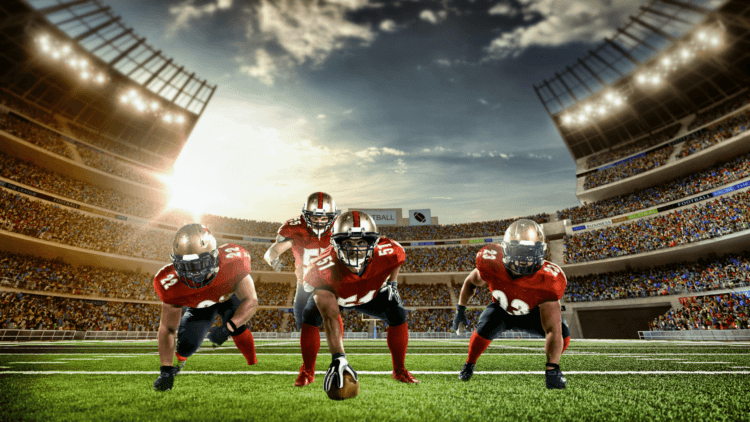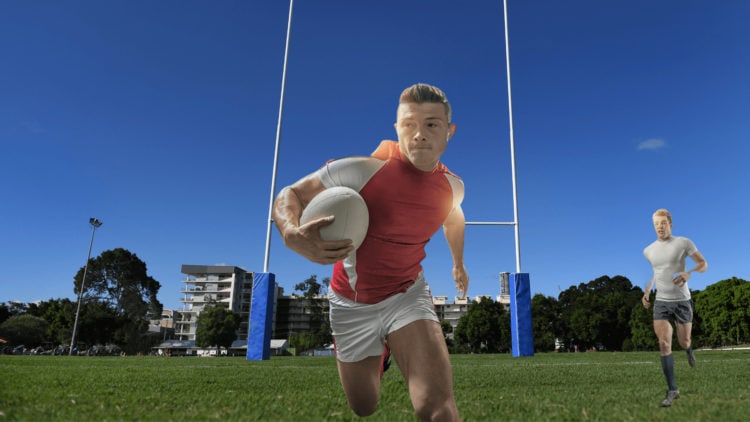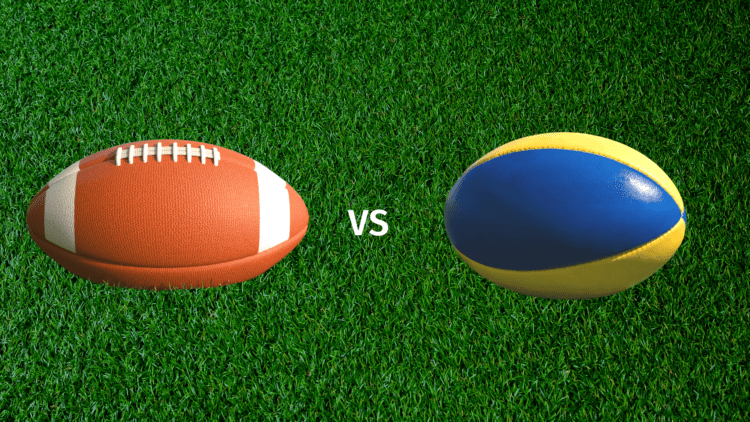
Rugby and American football are two different sports with many similarities. In fact, at a glance, many people may even think they are the same sport called by two different names. The most obvious difference between the two sports is the equipment needed (American football requires more padding for its players). However, in reality, there’s much that separates these two sports as two completely different entities. Let’s go over the differences between rugby and American football!
DIFFERENCE BETWEEN AMERICAN FOOTBALL AND RUGBY
FIELD
A standard, rectangular American football field is 100 yards long between the goal lines and 53 yards wide, with two end zones that are 10 yards each. The field is divided into several yard lines, with the 50-yard one in the center and the 10-yard one closest to the end zone. Behind each end zone is a 30-foot tall goal post, with an initial base of 10 feet high and two 20-foot high poles on each side.
Meanwhile, rugby fields are longer and wider than American football fields. Specifically, a rugby court is often 110 yards long between the goal lines and 74 yards wide. The goalpost is also higher than that in American football, with each being 51 feet tall. However, with that said, it is still possible to play rugby on an American football field.
AMERICAN FOOTBALL POSITIONS

In American football, there are always 11 players per team on the field (similar to soccer). These players are divided into offensive and defensive lineups, as well as special teams.
OFFENSIVE LINEUP
- Quarterback: The most prominent part of the offensive lineup, the quarterback will receive the ball at the start of the play and initiate the offense either by passing, running, or handing off the ball.
- Offensive Linemen: These are five strong, powerful players tasked with blocking opposing players and preventing them from tackling the quarterback.
- Wide Receivers: These are quick, agile players responsible for receiving passes from the quarterback, running down the field, and scoring touchdowns for their team.
- Running Backs: These can either be tall, bruising players or small, fast players, often positioned behind the quarterback. During the game, running backs are tasked with running the ball effectively to the offense. Their duties range from receiving handoffs from the quarterback and serving as a receiver to catching passes or blocking like linemen.
DEFENSE
- Defensive Linemen: The defensive linemen are positioned across the offensive line and serve as the first obstacle to the opponent’s attack. Their primary responsibility is to prevent the offensive line from scoring by tackling or scoring turnovers.
- Linebackers: Often standing behind the defensive line, linebackers’ main goal range from chasing down the opponent quarterback, backing up wide receivers, or stopping the run.
- Defensive Backs: These are extremely tough and fast players who serve as the last line of defense. Defensive backs also need to see the whole field so that they can cover receivers and make prompt tackles to stop running plays around the outside of the touchline.
SPECIAL TEAMS
One of the most overlooked units in American football, special teams are actually crucial in determining a game’s outcome. These teams consist of squad members who are neither part of the offensive nor defensive line and only play up to 20% of the game’s duration. Special teams, which include kickers, punters, kickoff returners, and receivers, will be on the field during kicking plays.
RUGBY POSITIONS

Meanwhile, in a rugby match, there are always 15 players per team on the field, divided into two categories: 7 backs and 8 forwards.
BACKS
- Scrum-Half: The scrum-half is one of the most important positions to build up attacks. Playing behind the forwards, the scrum-half will use his speed and vision to control when the ball is delivered to the back.
- Fly-Half: A key part in the attack build-up, the fly-half is responsible for passing the ball to the centers. Wearing the number 10, the fly-half is often tasked with doing penalties and drop goal attempts. In defense, the fly-half will support the backs to ensure every opposition player is covered, thus forestalling attacks.
- 2 Wings: Like in soccer, the wings’ most potent weapon is the incredible pace along the sides of the pitch. In attack, the wings are often a team’s finisher.
- 2 Centers: Consisting of the inside center and the outside center, the centers need strength, stamina, and dueling abilities to tackle opposition attacks. In team attacks, their main goal is to break the defensive line or create space and opportunities for teammates.
- Full-back: Often positioned behind the entire back line, the full-back serves as the last line of defense. They must receive opposition kicks, tackle opposition players, and prevent them from scoring.
FORWARDS
- Props: usually the strongest player on the pitch, the loosehead prop relies on their size to win head-to-head competitions. Their role is to support jumpers and protect the ball.
- Hooker: standing between the two props, the hooker is responsible for throwing the ball at the start of the play, controlling the timing of the scrum, and gaining possession in the scrum.
- 2 Locks: The locks are responsible for jumping and winning the ball during a lineout and locking the scrum into position. These players need to be strong and aggressive so that they can gain an advantage while jumping.
- 2 Flankers: Flankers are all-rounded players responsible for winning possession at any open play, collecting short passes, and making tackles. They boast both speed and strength.
- Number Eight: Similar to the flankers, a number eight’s role is to support play and tackle during open play. Together, they form a trio known as the back row.
GAMEPLAY DURATION
American football usually has four 15-minute quarters, with a half-time interval after the second one. In addition, there’s a short break during the changeover from offense to defense.
Meanwhile, rugby is much more like soccer. A game is divided into two 40-minute halves, with a 10-minute interval between them.
SCORING SYSTEMS

In both American football and rugby, players can score points in four ways.
AMERICAN FOOTBALL
- Touchdown: This is the most popular way to score points. When a player succeeds in scoring a touchdown by either receiving a pass from a quarterback or by running into the red zone while holding the ball, he earns his team six points.
- Field goal: A successful field goal attempt will earn the team three points.
- Safety: Safety gives the team two points when its defensive line succeeds in tackling opposition players in their own end zone.
- Try: A try is an opportunity to score one or two additional points after a touchdown.
RUGBY
- Try: A successful try is when a player carries the rugby ball behind the opponent’s touchline, earning his team five points.
- Conversion: After scoring tries, teams are given a free kick that can earn two extra points.
- Penalty kick: When players’ counterparts in the opposition team commit a foul, a rugby team can win three points.
- Drop goal: Teams can earn three points for a drop goal when a player drop kicks the ball through the opponent’s posts. This is the least popular method of scoring.
- 30 GAMES TO PLAY OVER TEXT - April 22, 2024
- 20+ FREE PRINTABLE BABY SHOWER GAMES - April 16, 2024
- 20+ College Party Games for the Best Night Ever! - April 2, 2024